Tuesday 26 March 2013
The Unstriped Ground Squirrel - Africa's Little Survivor
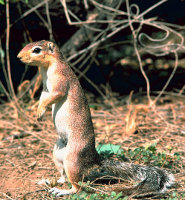
The
unstriped Ground Squirrel (Xerus rutilus) is a member of the
rodent family. Families and communities all live together in burrows and colonies in and around parts of Africa, like Ethiopia, Kenya, Uganda, Sudan, Somalia, Djibouti, and Eritea. They live in the dry Savanna, subtropical areas and shrub land. This ground squirrel is pretty much a vegetarian they love to eat roots, seeds, fruit, pods, grains, insects, bird eggs and small vertebrates. These squirrels will eat basically anything hanging in a tree or anything crawling around that is small enough to fit in their little mouths.
The unstriped squirrel’s status is labeled as "little concern" because it is in abundance in the African areas; it is not on the verge of extinction.
The unstriped ground squirrel weighs about .6kg which is approximately 1.3 pounds. When measured length wise they can measure 10-12 inches long. These small animals are sometimes kept as pets, but most farmers see these animals as pest to their crops.
You can help spreading the word about this animal by liking it on facebook
Permanent Link
Monday 25 March 2013
Coypu - a Web-Footed Rodent
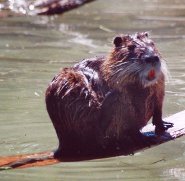
The
Coypu (
Myocastor coypus), a large rodent herbivore, was originally found in South America although it has been introduced to various other regions such as Africa, Europe, Asia, and North America. It was introduced predominantly for its fur. Although they were initially believed to be a valuable species, they have become largely invasive through their destructive burrowing. The animal is typically found near rivers in burrows surrounding the water and eats primarily river plants.
The coypu looks similar to a beaver or a gigantic rat and has often been mistaken for
muskrats although the muskrat is significantly smaller. The animal weighs between 5 to 9 kilograms or 11 to 20 pounds with a body between 40 to 60 centimeters or 16 to 24 inches. Their tails measure approximately 30 to 45 centimeters or 12 to 18 inches in length. The coypu has dark brown outer fur which is quite coarse and softer fur underneath. The animal is quite unique due to its white muzzle as well as its peculiar hind feet, which are distinctly webbed. In addition, female coypu have nipples which are located high on their body so that they are able to feed the young while floating.
The coypu has become extinct in many of their natural, native habitats due to hunting. Because of this, farms were established during the 19th and 20th centuries. The initial farms were established in Argentina and were later introduced in Asia, North America, and Europe. However, these fur farms have not been successful and most of the animals have been released back into the wild creating problems in the surrounding habitats due to the coypu’s excessive eating of plants, burrowing, chewing of tires and paneling on homes, as well as the destruction of irrigation systems. They are not currently considered to an endangered species. Predators of the coypu exist both on land as well as in the water. Their primary predators include alligators, red wolves, and well as wild cats.
Although they are not currently considered an overall endangered species, they do undergo periods of population reduction particularly during harsh winters. The animal is not very resilient in the cold and often undergoes frostbite in their tails which can cause infection and, potentially, death. Because of this, there are areas in which the animal has become extinct including parts of Scandinavia. However, during mild winters, the animals survive quite well particularly in areas of the northwestern United States.
Picture of the coypu by J. Patrick Fischer, licensed under the
Creative Commons Attribution-Share Alike 2.5 Generic license.
You can help spreading the word about this animal by liking it on facebook
Permanent Link
Friday 22 March 2013
Mountain Weasel - Nocturnal Athlete
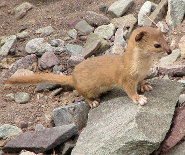
The
Mountain Weasel (
Mustela altaica) is a species of weasel that prefers to live at high altitudes, usually over 11,500 feet (3,505 meters). This species is sometimes referred to as the Pale Weasel or Altai Weasel, as well. Mountain Weasels have two coats; they molt their winter coats, revealing their summer coats, when the weather becomes warm each spring. The summer coat may be gray or gray-brown and sometimes consist of some pale yellow, as well. The winter coat is made of up a darker yellow colored fur, as well as some brown.
Male and female Mountain weasels differ slightly in size. The males are typically 12 to 17 inches (30.4 to 43 centimeters) long, from the nose to the tip of the tail. They weigh between eight and 12 ounces (.2 and .3 kilograms). The females range from 12 to 15 inches (30.4 to 38 centimeters) in length and weigh from four to eight ounces (.1 to .2 kilograms). Females feature smaller heads and shorter tails than males.
Mountain Weasels may be found in parts of East Asia, including the Himalayas, Mongolia, Korea, and northern China. They also sometimes appear in parts of Russia. They are most commonly found, however, in Ladakh, India. They reside in tree trunks, rocky caves or crevices, and the abandoned burrows of other animals. Sometimes, mountain weasels even take over the burrows of their prey. This prey may include small
rodents, such as voles, and lizards. In turn, the weasels are occasionally preyed upon by large birds, wolves, or foxes.
Mountain Weasels live where there is an abundance of green vegetation at high altitudes. Their habitat is in danger of terrible depletion, making the future unclear for this species. Mountain Weasels are considered "near threatened" due to a significant decline in numbers in recent years.
The Mountain Weasel may be considered a natural athlete due to its extreme agility and versatility. Both males and females are capable of incredible feats of climbing, swimming, and running. They are natural contortionists and are among the most nimble animals in the world. Mountain Weasels typically sleep during the day, aside from a rare daytime hunt, but they can be observed capering and performing gymnastics nightly. They are solitary creatures except for when mating, though, so one mustn't expect a group show.
Mountain Weasels are beautiful, remarkably agile creatures whose high-altitude habitat must be protected in order to ensure that they are allowed to continue to romp and hunt on the Asian mountain slopes where they reside.
Picture of the mountain weasel by Karunakar Rayker, licensed under
Creative Commons Attribution-Share Alike 2.0 Generic license.
You can help spreading the word about this animal by liking it on facebook
Permanent Link
Thursday 21 March 2013
The Brown Lemur - Get Ready for a Tall Tail
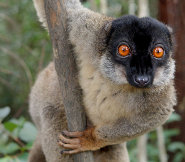
The
Brown lemur (
Eulemur fulvus) is a medium-sized primate. They are found on the island of Madagascar, located off the southeastern coast of Africa in the Indian Ocean. They have also been found to live on
Mayotte, an island to the north of Madagascar. These lemurs range in length from 84 to 101 centimeters (33 to 40 inches), and weigh in at a mere two to four kilograms (four to ten pounds). Interestingly, the lemur's tail is usually as long as or longer than their body!
Brown lemurs are typically herbivores, eating fruits, flowers, and leaves, but they will, on occasion, eat centipedes, millipedes, and other insects. They will also consume bark, sap, and clay. Their habitat of forests, both rain forests and dry forests, ensures that they have an ample supply of food, with plenty of plant and animal life around to nibble on.
They are excellent jumpers, moving from tree to tree with ease and use their tail for balance when needed. They spend less than 2% of their time on the ground. When on the ground, they usually run around on all 4 legs.
Brown lemurs typically live in groups of 5 to 12 individuals. There doesn't appear to be any hierarchy among these groups and one group may claim up to 20 hectacres of territory. The gestation period for a Brown lemur is 120 days and the female usually gives birth to only one offspring, though twins have been reported. They can live to be 25 to 30 years old, and may live to be even older than that in captivity.
In terms of conservation status, Brown lemurs are considered to be "vulnerable". This is largely due to loss of habitat, as forests are destroyed by humans. As the human population of Madagascar grows, more forests are being destroyed for agricultural purposes, both the planting of crops and the grazing of animals. Lemurs are found in a variety of protected areas, parks, and in zoos, which should help to preserve their population. Their natural predators are eagles, hawks, or domestic cats who may eat a new born.
Picture of the Brown Lemur by
David Dennis, licensed under
Creative Commons Attribution-Share Alike 2.0 Generic
You can help spreading the word about this animal by liking it on facebook
Permanent Link
Wednesday 20 March 2013
Hector's Beaked Whale - Vacuum of the Sea
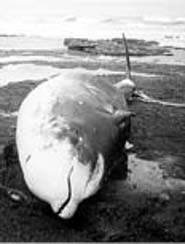
The
Hector's beaked whale (
Mesoplodon hectori) is less well known than many of its cetacean cousins, and is a relatively unique specimen within the world of whales and dolphins. While the presence of the beak may draw more comparisons to the latter, genetically and functionally speaking it belongs among the ranks of the former. The Hector's beaked whale is incredibly rare, and thus comparatively little is known about it. However, it stands as one of the ocean's most fascinating creatures.
Physical Characteristics
The smallest of the beaked whales, these oceanic mammals generally come in at around 4.2 meters (13.8 ft), and weigh about 1 tonne, or 2,204 lbs, in size closer to a
Bottlenose dolphin than most whale species. Its most prominent physical characteristic is the beak which it shares with other members of its genus.
Distribution
Generally, the Hector's beaked whale prefers a temperate climate. Many have been recorded around New Zealand, but observations have placed them near Tasmania, South Africa, and the southern tip of South America.
Behavior
What separates the beaked whales from other cetacean species is their method of consuming their prey. While larger whales have baleen and eat mostly plankton, and killer whales and dolphins use more traditional hunting methods, the beaked whales hunt by suction. Their primary prey consists of fish and squid hunted in deep water.
Conservation
Unlike many aquatic species, the Hector's beaked whale is presumed to be safe from extinction, at least for the moment. It has not been observed live in the wild since 2007, and has never been hunted for sport or for food. Many beaked whale species display an above-average sensitivity to aquatic sonar, however, and naval exercises have been known to inflict casualties on other species in the genus. Due to its deep water habitat, the Hector's beaked whale is presumed to be safe from such interference. While numbers of the species are probably somewhat low, this is presumed to be natural, and the species is not marked as endangered.
The Mystery
Little is known about the Hector's beaked whale. Until recently, no specimens had ever been properly described; the only ones recorded were in fact Perrin's beaked whales, a similar species. As such, little is known about how this species breeds, how it behaves socially, and what its challenges are within its environment. Its bizarre capacity for suction remains a fascination for scientists, who hope to unlock its mysteries someday.
You can help spreading the word about this animal by liking it on facebook
Permanent Link
Monday 18 March 2013
Grant's Gazelle -The Contrary Migrator
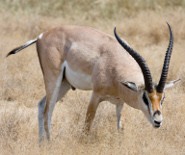
The
Grant's gazelle (
Gazella granti), a species of gazelle, roams the grasslands from Tanzania to Ethiopia, Sudan, as well as along the coast of Kenya. The animal stands between 76 and 91 centimeters or 30 to 36 inches from bottom of the hooves to the shoulder blade and its weight ranges from 45 to 65 kilograms or 100 to 145 pounds. They are differentiated from other species of gazelles by their lyre shaped horns.
The Grant's gazelle lives in the open plains as well as in the low shrublands. The gazelle tends to avoid high grasses as this compromises their ability to spot their predators. Along with most other animals in the ungulate family, they are migratory but migrate in the opposite direction of most African animals. Instead of moving towards water, the Grant's gazelle can survive on vegetation without access to water. They get most of the water from the plants which they consume. They eat primarily brush and shrubs during the summer months and oats and crispy plants during the remainder of the year. The predominant predators of the Grant's gazelle are cheetahs, although the
cheetah has been known to prefer the
Thomson's gazelle. Other predators include the
African wild dog, jackals, as well as humans.
The male gazelles are quite territorial and they gather all of the females that enter into their territories into their herd. When the female gazelle is estrous, the male will guard the females and prevent other males from mating with the females in their herd. Single male gazelles live in herds of young adolescent bucks as well as bucks which do not have their own territories. In order for a male to be permitted to enter a group, they must perform power displays. However, male gazelles, unlike the females, are permitted to leave the herd at any point they choose.
The Grant's gazelle becomes sexually mature at the age of 18 months. When sexually mature, the male gazelle will determine whether or not a female is in estrous and, if she is, he will mate with her. After the female becomes pregnant, the gestation period lasts for approximately 198 days.
This species of gazelle is not endangered although they are no longer present in some areas in which they used to live. Major issues include hunting as well as the removal of their natural habitat. They largely live within nature reserves and, if these nature reserves were to be depleted, the species may unfortunately become endangered.
Picture of the Grant's gazelle by Ikiwaner, Ngorongoro crater, licensed under
GFDL
You can help spreading the word about this animal by liking it on facebook
Permanent Link
Wednesday 13 March 2013
The Norway Lemming - Migratory, Not Suicidal
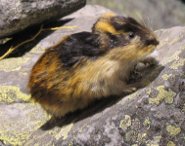
The
Norway lemming (Lemmus lemmus) is a common type of lemming found in the tundras of Scandinavia and Western Russia. Norway lemmings are generally 13 to 15 centimeters (about 5 to 6 inches), with an added tail length of 2 centimeters (0.8 inch), and range in weight from 28 grams to 113 grams (1 to 4 ounces).
Besides its namesake country of Norway, these lemmings are found in Sweden, Finland, Western Russia, and a number of islands outlying from these countries. They live in a number of habitats, including grasslands, shrubs, and occasionally wetlands. They are fully comfortable in snow, and during the winter, tunnel along the ground underneath the snow in order to find food and shelter. Their fur is waterproof, and grows thicker in the winter, so they are not affected as dramatically by the snow. When the snow melts during the summer, the Norway lemmings will burrow underground to build nests, and line them with grass for insulation.
Their diet consists primarily of the grasses, shrubs, and moss around them, although in the summer they will eat insects as well. Because of their small size, they are prey to a number of animals, notably, owls, buzzards, skua (or jaegers),
wolverines, foxes and
ermines.
One of the most pervasive beliefs about Norway lemmings, and lemmings in general, is that they periodically commit mass suicide either by running off cliffs or drowning themselves. In fact, this is patently untrue. The Norway lemming is remarkable in that they experience massive population explosions every three or four years, during which they consume all of the food around them, and are forced to migrate in large numbers to find more food. During this migration, they often attempt to swim across large bodies of water, wear themselves out, and drown. While all lemmings experience periodic population explosions, Norway lemmings are the only species that migrates as a result. Norway lemmings will sometimes migrate on a smaller scale in order to escape an environment that is too harsh, such as a particularly cold winter or hot summer, but this rarely causes the type of large scale death that migration brought on by a population explosion, also known as swarming, does.
Norway lemmings are not currently endangered, and are in fact classified as a species of least concern by the International Union for the Conservation of Nature and Natural Resources, which produces the well known "Red List" of threatened species. However, there is some concern about the lemming's status in light of global warming, with the BBC reporting in 2008 that climate change is causing lemmings to have less swarming years, and leading to a lighter snowfall. This leads to a reduction in the thick, insulating snow layer, which makes it harder for the Norway lemmings to survive the winter, and a correspondingly lower population.
You can help spreading the word about this animal by liking it on facebook
Permanent Link
Monday 11 March 2013
The Lesser Mouse Deer - A Tiny Superhero
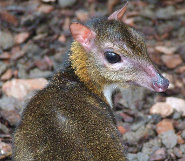
The
lesser mouse deer or chevrotain (
Tragulus javanicus) is the smallest hoofed mammal in the world. Although it is a shy and secretive forest dwelling relative of the deer and rarely seen, it is very well known throughout Southeast Asia. Its species name T. kanchil recalls its Malay name 'Sang Kancil', a renowned trickster and folk hero.
At first glance, the lesser mouse deer resembles a tiny, rabbit-sized deer that walks on its tiptoes. Adults normally measure about eighteen inches (45 cm) long. Standing on their pencil-thin legs, shoulder height is a mere twelve inches (30 cm), and they weigh about five pounds (2.3 kg). Lesser mouse deer have soft reddish-brown fur marked with a pattern of pale spots or stripes running along the sides of the neck and a pale-colored underside. Unlike deer, the males have no antlers, but do sport a pair of canine teeth that can be seen projecting downward from the upper jaw like two tiny tusks. Males make use of their teeth to defend themselves and their mates against rivals.
The natural habitat of the lesser mouse deer is the moist tropical lowland forest regions of Brunei, Cambodia, Indonesia (Sumatra, Java and Borneo), Laos, Malaysia, Myanmar (Isthmus of Kra), Singapore, southern China, Thailand and Vietnam. Mouse deer feed on fallen fruits, tender shoots, young leaves and fungi found along the ground and in the low, dense vegetation they inhabit. These tiny browsers are crepuscular feeders, meaning that they prefer being active in the dim light of dusk and dawn. In their forest home, mouse deer travel along paths which resemble tunnels of thick vegetation leading to resting places and feeding areas. Males are very territorial and they regularly mark their territories with scent glands found under their chins.
Female mouse deer may give birth to a single fawn at any time of year. Like other hoofed animals, newborn fawns are precocial and stand within thirty minutes of being born. The does wean their fawns at around twelve weeks. The fawns can breed at five to six months, and may live for twelve years.
The natural predators of the lesser mouse deer include
crocodiles, snakes, birds of prey and all forest cats. They are taken by humans throughout most of their range for meat and skins. Hunting, trapping, roaming packs of dogs and habitat destruction pose their biggest threats.
Sang kancil (pronounced: Kahn-cheel), the diminutive but wise mouse deer, holds a place of pride in Malay and Indonesian folklore. The tiny hero is cunning and intelligent, and able to prevail over larger tyrants and foes. In these tales, the only thing "lesser" about the lesser mouse deer is his size.
Picture of the lesser mouse deer by
Linda Kenney from United Kingdom, licensed under
Creative Commons Attribution-Share Alike 2.0 Generic
You can help spreading the word about this animal by liking it on facebook
Permanent Link
Thursday 07 March 2013
Striped hyena - master scavenger
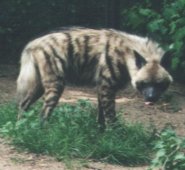
They have big heads, big eyes, and ears that are also big, yet this is not a giant animal. The
Striped Hyena (
Hyaena hyaena) has a strong jaw, and both genders do not have a significant difference in appearances. The coloring of the coat is either gray or brown, and dark stripes run the length of the Striped Hyena's body. In captivity, it could reach a life span of 24 years. Striped Hyenas live in thornbrushes, stony and desert grounds.
Thought of as a solitary being, the Striped Hyena has a complicated social setup. The striped hyenas do not emit whooping calls that the spotted hyenas emit. Instead, the former have greeting rituals, and far-distance communications are done via scent-marking. More often than not, the Striped Hyena is nocturnal, foraging alone or with a single companion. Group member may eat at a single setting, but it is a very rare occurrence. Fact is, they would avoid competitions over food, and speaking of foods, they are scavengers adn they spend a lot of time looking for carrion.
The newborns are blind, and they are produced after a gestation time of about ninety days, approximately. The female has half a dozen nipples, while the brown kind has less. The adults would bring food to the "nesting dens" to feed the young.
Just like so many other animals, the numbers of these hyenas are going down. The question now is: are they endangered at present? Not yet, but they are rare, and this rare could become 'threatened' sooner or later. This is due to two main reasons: habitat destruction and hunting. Those in the Arabian Peninsula are facing extinction actually, and if mankind does not do something dramatic to meet this developments, this kind of hyena may totally disappear in this part of the globe.
Interesting fact: This hyena could be called a "master scavenger", it is capable of digesting things other animals would not dare "touch". One could take in bones, while indigestible matters such as horns are regurgitated.
Picture of the striped hyena by
Martin Bayer, licensed under
GFDL
You can help spreading the word about this animal by liking it on facebook
Permanent Link
 The unstriped Ground Squirrel (Xerus rutilus) is a member of the rodent family. Families and communities all live together in burrows and colonies in and around parts of Africa, like Ethiopia, Kenya, Uganda, Sudan, Somalia, Djibouti, and Eritea. They live in the dry Savanna, subtropical areas and shrub land. This ground squirrel is pretty much a vegetarian they love to eat roots, seeds, fruit, pods, grains, insects, bird eggs and small vertebrates. These squirrels will eat basically anything hanging in a tree or anything crawling around that is small enough to fit in their little mouths.
The unstriped Ground Squirrel (Xerus rutilus) is a member of the rodent family. Families and communities all live together in burrows and colonies in and around parts of Africa, like Ethiopia, Kenya, Uganda, Sudan, Somalia, Djibouti, and Eritea. They live in the dry Savanna, subtropical areas and shrub land. This ground squirrel is pretty much a vegetarian they love to eat roots, seeds, fruit, pods, grains, insects, bird eggs and small vertebrates. These squirrels will eat basically anything hanging in a tree or anything crawling around that is small enough to fit in their little mouths.
 The
The  The
The  The
The  The
The  The
The  The
The  The
The  They have big heads, big eyes, and ears that are also big, yet this is not a giant animal. The
They have big heads, big eyes, and ears that are also big, yet this is not a giant animal. The